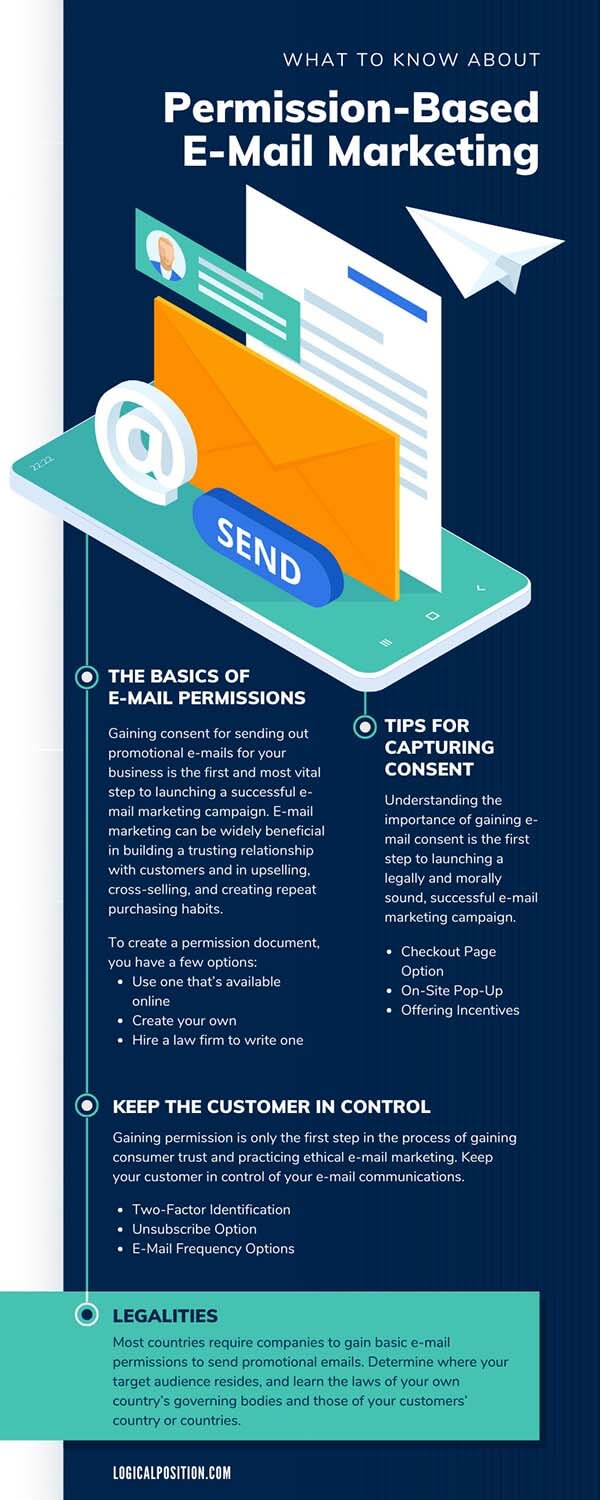E-mail marketing is one of the most lucrative investments companies can make. The return-on-investment (ROI) potential is astonishing, and it builds relationships with customers. E-mail marketing consists of sending promotional e-mails to a list of current or future customers.
People can sign up to receive e-mails, or companies can also acquire e-mail addresses via other methods, although this is not recommended. When a person receives an e-mail from a brand to whom they did not give consent, there are many potential consequences for that brand. If you’re considering breaking into the world of e-mail marketing, consider what to know about permission-based e-mail marketing.
The Basics of E-Mail Permissions
Gaining consent for sending out promotional e-mails for your business is the first and most vital step to launching a successful e-mail marketing campaign. E-mail marketing can be widely beneficial in building a trusting relationship with customers and in upselling, cross-selling, and creating repeat purchasing habits.
All the positive results that companies experience from e-mail marketing only come if the users consented or gave permission to the business to send those e-mails. Permissions are needed for more reasons than just legality—customers do not want unsolicited e-mails from brands, whether they’re customers of a certain brand or not.
There are many things involved with gaining e-mail permissions, but usually a simple checkbox with a link to a permission document is plenty to gain customer consent.
To create a permission document, you have a few options:
- Use one that’s available online.
- Create your own.
- Hire a law firm to write one.
Tips for Capturing Consent
Understanding the importance of gaining e-mail consent is the first step to launching a legally and morally sound, successful e-mail marketing campaign. Check out a few easy ways to capture consent from your potential e-mail subscribers:
Checkout Page Option
One of the most successful options to capture e-mail consent is providing a pre-checked box during the checkout process. Many brands use this option. Consider putting a box that customers can uncheck on the shipping information page during the checkout process. Pre-checking the box is the best option because, while customers can uncheck it, most do not, which grows your e-mail list at a faster rate.
On-Site Pop-Up
Another option to gain e-mail consent is to create a pop-up on your website. There are many ways to ask for e-mail permissions in a pop-up. Pop-ups can populate on landing pages or a home page. They’re also effective on pages that first-time buyers often visit. Analyze your site and test pages on which the pop-up might be most effective to see the best possible results for your site.
Offering Incentives
Offering incentives can drive a customer who is unsure whether they want to provide e-mail consent to do so. You can add incentives to pop-ups or on checkout pages. Here are a few incentives many brands use:
- A percentage off the next purchase
- Exclusive access to deals and sales
- Regular coupons
- Free shipping on the next order
- Upgraded shipping method
- Free gift or add-on to the next order
Remember, it’s never too late to right past wrongs in e-mail marketing. If you’re reading this and realizing that you send e-mails without a consent form, worry not. Stop sending promotional e-mails right away, and send out one e-mail to your entire list with no promotions at all to ask for consent. Then, respect the answers you get and refine your list from there.
Legalities
Online privacy is a hot topic among many nations and governing powers. Many regulatory agencies are still working to decide the best ways to balance information-sharing and privacy online. Most countries require companies to gain basic e-mail permissions to send promotional emails. Some governing powers require further permissions and have other regulations. Determine where your target audience resides, and learn the laws of your own country’s governing bodies and those of your customers’ country or countries. In the United States, for example, there’s a penalty of up to $43,000 per e-mail infraction. That means up to $43,000 per e-mail sent without consent. For a company with an e-mail list of 2,000, that translates to a maximum of 86 million dollars in fines. Gain consent before sending e-mails!
When companies purchase e-mails from reputable sources, the permissions may be legal, but the trust of the consumer is not there. Larger brands tend to put clauses in e-mail permission forms stating that the customer consents to receive e-mails from other brands so that the company can sell their e-mail list. However, customers rarely read this fine print. While legally obtained, these permissions are not earned. If you want results and trust to build from e-mail campaigns, buying e-mails is not the way to do it. Gaining consent in a legal and organic way leads to much higher and stronger results.
Keep the Customer in Control
Gaining permission is only the first step in the process of gaining consumer trust and practicing ethical e-mail marketing. Keep your customer in control of your e-mail communications. When it comes to sending e-mails, especially for smaller senders, it’s more about not creeping out the customer. Ensure you have permissions that customers intentionally gave you.
Two-Factor Identification
Using a two-factor identification method ensures your customers really want to get your e-mails. It also works to keep out bots, which is a common problem. When a person signs up for e-mails, the initial send should double-check that they want to subscribe.
Unsubscribe Option
Always include an easy-to-find unsubscribe button in all your sends. This allows the customer to stay in control of what they receive and to not feel trapped in their cluttered inbox. When they see the unsubscribe button and don’t click it, they are taking control and actively deciding to receive e-mails from your brand.
E-Mail Frequency Options
Smaller brands may not need this option, but for larger brands, adding an option for customers to adjust the frequency of sends can be beneficial. Some big companies send out one or more e-mails a day to their subscriber lists. This may be too much for a customer to handle, so they unsubscribe even though they still wanted to see content. Adding a custom option to receive one e-mail per week or per month instead of daily updates can save your list and keep customers informed on the most important deals and communications.

There are many considerations for e-mail marketing. What to know about permission-based e-mail marketing is that allowing your customer to take control comes with many benefits. Consider seeking out professionally managed e-mail marketing services from Logical Position. We are a professional agency that’s well versed in laws, permissions, and ROI for e-mail sends. Contact us today for a free consultation.




